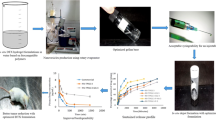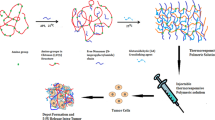Abstract
Purpose
Thermoresponsive hydrogels are gels which have different properties at varying temperatures. The objective of this study was to assess the material characteristics, imaging properties and chemotherapeutic drug release profile of a novel radiopaque thermoresponsive hydrogel in vitro, which is liquid at room temperature but solidifies at body temperature, to determine potential suitability for intratumoural delivery.
Materials and Methods
An iodinated radiopaque thermoresponsive hydrogel was formulated using iodixanol at a range of concentrations and assessed for sol–gel transition, radiopacity and imaging using CT and US. A lead formulation containing iodixanol at a concentration of 9.22% weight by weight (w/w, g of iodixanol per g of hydrogel) was evaluated in vitro for injectability, disintegration and dual drug release of cisplatin and paclitaxel from the hydrogel formulation.
Results
Radiopacity of the hydrogel increased in a concentration-dependent manner, but the highest concentration of iodixanol evaluated in this study (13.83% w/w) adversely affected the sol–gel transition of the hydrogel; therefore, 9.22% w/w iodixanol hydrogel was identified as the lead formulation. This formulation was readily visible on both CT and US. The formulation was hand injectable through a range of clinically relevant devices, had a sustained disintegration profile for up to 28 days and was able to deliver a sustained release of chemotherapeutic drug for up to 10 days.
Conclusions
Favourable in vitro and ex vivo imaging and material characteristics of this thermoresponsive gel are demonstrated, suggesting potential interventional oncology applications for image-guided intratumoural delivery of sustained-release chemotherapy.





Similar content being viewed by others
References
Senthebane DA, Rowe A, Thomford NE, Shipanga H, Munro D, Al Mazeedi MAM, et al. The role of tumor microenvironment in chemoresistance: to survive, keep your enemies closer. Int J Mol Sci. 2017;18(7):1586. https://doi.org/10.3390/ijms18071586.
Schaefer L, Reinhardt DP. Special issue: extracellular matrix: therapeutic tools and targets in cancer treatment. Adv Drug Deliv Rev. 2016;97:1–3. https://doi.org/10.1016/j.addr.2016.01.001.
Pearce A, Haas M, Viney R, Pearson S-A, Haywood P, Brown C, et al. Incidence and severity of self-reported chemotherapy side effects in routine care: a prospective cohort study. PLoS ONE. 2017;12(10):e0184360. https://doi.org/10.1371/journal.pone.0184360.
Wolinsky JB, Colson YL, Grinstaff MW. Local drug delivery strategies for cancer treatment: gels, nanoparticles, polymeric films, rods, and wafers. J Control Release. 2012. https://doi.org/10.1016/j.jconrel.2011.11.031.
Celikoglu F, Celikoglu SI, Goldberg EP. Techniques for intratumoral chemotherapy of lung cancer by bronchoscopic drug delivery. Cancer Ther. 2008;6:545–52.
Hohenforst-Schmidt W, Zarogoulidis P, Darwiche K, Vogl T, Goldberg EP, Huang H, et al. Intratumoral chemotherapy for lung cancer: re-challenge current targeted therapies. Drug Design Dev Ther. 2013;7:571–83. https://doi.org/10.2147/DDDT.S46393.
Levy MJ, Alberts SR, Bamlet WR, Burch PA, Farnell MB, Gleeson FC, et al. EUS-guided fine-needle injection of gemcitabine for locally advanced and metastatic pancreatic cancer. Gastrointest Endosc. 2017;86(1):161–9. https://doi.org/10.1016/j.gie.2016.11.014.
Hecht JR, Farrell JJ, Senzer N, Nemunaitis J, Rosemurgy A, Chung T, et al. EUS or percutaneously guided intratumoral TNFerade biologic with 5-fluorouracil and radiotherapy for first-line treatment of locally advanced pancreatic cancer: a phase I/II study. Gastrointest Endosc. 2012;75(2):332–8. https://doi.org/10.1016/j.gie.2011.10.007.
Klouda L. Thermoresponsive hydrogels in biomedical applications: a seven-year update. Eur J Pharm Biopharm. 2015;97:338–49. https://doi.org/10.1016/j.ejpb.2015.05.017.
DuVall GA, Tarabar D, Seidel RH, Elstad NL, Fowers KD. Phase 2: a dose-escalation study of OncoGel (ReGel/paclitaxel), a controlled-release formulation of paclitaxel, as adjunctive local therapy to external-beam radiation in patients with inoperable esophageal cancer. Anticancer Drugs. 2009;20(2):89–95. https://doi.org/10.1097/CAD.0b013e3283222c12.
Buwalda SJ, Boere KWM, Dijkstra PJ, Feijen J, Vermonden T, Hennink WE. Hydrogels in a historical perspective: From simple networks to smart materials. J Control Release. 2014;190:254–73. https://doi.org/10.1016/j.jconrel.2014.03.052.
Ward MA, Georgiou TK. Thermoresponsive polymers for biomedical applications. Polymers. 2011;3(4):1215–42. https://doi.org/10.3390/polym3031215.
Bajpai AK, Shukla SK, Bhanu S, Kankane S. Responsive polymers in controlled drug delivery. Prog Polym Sci. 2008;33(11):1088–118. https://doi.org/10.1016/j.progpolymsci.2008.07.005.
Chen YY, Wu HC, Sun JS, Dong GC, Wang TW. Injectable and thermoresponsive self-assembled nanocomposite hydrogel for long-term anticancer drug delivery. Langmuir. 2013;29(11):3721–9. https://doi.org/10.1021/la400268p.
Donin NM, Duarte S, Lenis AT, Caliliw R, Torres C, Smithson A, et al. Sustained-release formulation of mitomycin C to the upper urinary tract using a thermosensitive polymer: a preclinical study. Urology. 2017;99:270–7. https://doi.org/10.1016/j.urology.2016.09.039.
Jonsson Comprehensive Cancer Center. Compassionate use of MitoGel in upper tract urothelial carcinoma (NCT02701023). Bethesda (MD): National Library of Medicine (US). 2000–2016. https://clinicaltrials.gov/ct2/show/NCT02701023.. Accessed 02 Mar 2017.
DeWitt JM, Murthy SK, Ardhanari R, DuVall GA, Wallner G, Litka P, et al. EUS-guided paclitaxel injection as an adjunctive therapy to systemic chemotherapy and concurrent external beam radiation before surgery for localized or locoregional esophageal cancer: a multicenter prospective randomized trial. Gastrointest Endosc. 2016;1:2–3. https://doi.org/10.1016/j.gie.2016.11.017.
United States Food and Drug Administration. FDA ODAC Briefing Document for NDA 21-236. IntraDose® (cisplatin/epinephrine) Injectable Gel for Recurrent Squamous Cell Carcinoma of the Head and Neck. 2001.
Fatimi A, Chabrot P, Berrahmoune S, Coutu JM, Soulez G, Lerouge S. A new injectable radiopaque chitosan-based sclerosing embolizing hydrogel for endovascular therapies. Acta Biomater. 2012;8(7):2712–21. https://doi.org/10.1016/j.actbio.2012.04.006.
Kraitzer A, Ofek L, Schreiber R, Zilberman M. Long-term in vitro study of paclitaxel-eluting bioresorbable core/shell fiber structures. J Controll Release. 2008;126(2):139–48. https://doi.org/10.1016/j.jconrel.2007.11.011.
Rungseevijitprapa W, Bodmeier R. Injectability of biodegradable in situ forming microparticle systems (ISM). Eur J Pharm Sci. 2009;36(4–5):524–31. https://doi.org/10.1016/j.ejps.2008.12.003.
Li J, Mooney DJ. Designing hydrogels for controlled drug delivery. Nat Rev Mater. 2016;1:16071. https://doi.org/10.1038/natrevmats.2016.71.
Cho JK, Hong JM, Han T, Yang HK, Song SC. Injectable and biodegradable poly(organophosphazene) hydrogel as a delivery system of docetaxel for cancer treatment. J Drug Target. 2013;21(6):564–73. https://doi.org/10.3109/1061186X.2013.776055.
Kim DY, Kwon DY, Kwon JS, Park JH, Park SH, Oh HJ, et al. Synergistic anti-tumor activity through combinational intratumoral injection of an in situ injectable drug depot. Biomaterials. 2016;85:232–45. https://doi.org/10.1016/j.biomaterials.2016.02.001.
Mao Y, Li X, Chen G, Wang S. Thermosensitive hydrogel system with paclitaxel liposomes used in localized drug delivery system for in situ treatment of tumor: better antitumor efficacy and lower toxicity. J Pharm Sci. 2016;105(1):194–204. https://doi.org/10.1002/jps.24693.
Funding
This study was funded by an Enterprise Ireland Commercialisation Fund (CF-2016-0431P) and a Royal College of Surgeons in Ireland School of Pharmacy bursary.
Author information
Authors and Affiliations
Corresponding author
Ethics declarations
Conflict of interest
The authors declare that they have no conflict of interest.
Human and Animal Rights
This article does not contain any studies with human participants or animals performed by any of the authors.
Informed Consent
For this type of study, informed consent is not required.
Consent for Publication
For this type of study consent for publication is not required.
Rights and permissions
About this article
Cite this article
Rossi, S.M., Murray, T.E., Cassidy, J. et al. A Custom Radiopaque Thermoresponsive Chemotherapy-Loaded Hydrogel for Intratumoural Injection: An In Vitro and Ex Vivo Assessment of Imaging Characteristics and Material Properties. Cardiovasc Intervent Radiol 42, 289–297 (2019). https://doi.org/10.1007/s00270-018-2103-0
Received:
Accepted:
Published:
Issue Date:
DOI: https://doi.org/10.1007/s00270-018-2103-0




